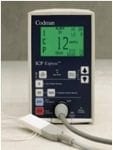1
/
of
1
River Medical
Codman ICP Monitor
Codman ICP Monitor
Regular price
$199.00
Regular price
Sale price
$199.00
Unit price
/
per
Tax included.
Couldn't load pickup availability
OVERVIEW
- intracranial pressure monitor
- aka ‘bolt’
USES/INDICATIONS
Suspected raised intracranial pressure
- severe head injury
— unable to monitor neurologically
— GCS < 8 and abnormal CT
— GCS <8 and normal CT with 2/3 of: age >40y, motor posturing and SBP <90 mmHg - stroke
- cerebral edema
- hydrocephalus
- hepatic encephalopathy
DESCRIPTION
- strain gauge tipped catheter or fiberoptic device
METHOD OF INSERTION AND/OR USE
- sterile technique
- bolt through fronto-parietal suture-line, in line with pupil
- zero at external auditory meatus
- penetrates through dura into CSF or intraparencymally
- held in place by bolt
OTHER INFORMATION
Interpretation of Waveforms
- High amplitude of 50-100mmHg sustained for 15 min (‘A waves’) – raised ICP
- Saw tooth with small changes in pressure every 0.5-2 minutes (‘B waves’) – poor intracranial compliance
- Low amplitude oscillations up to 20mmHg for 1 min (‘C waves’) – normal
- Flat ICP trace – compression or kinking of transducer
- Rounded appearance of the waveform – raised ICP
ADVANTAGES
- easy to insert (can be done at bedside)
- less invasive than EVD
- more accurate ICP measurements than extradural bolt
- produces high fidelity wave forms
- small
DISADVANTAGES/ COMPLICATIONS
- infection
- transducer tip may rest on brain and obstruct
- aspiration of CSF not possible
- tends to under-read pressures > 20mmHg
- intracranial transducer cannot be calibrated once in situ
- baseline drift (especially after 5 days)
- remember they don’t give an indication of infratentorial pressure
- no RCT evidence of benefit
Share




